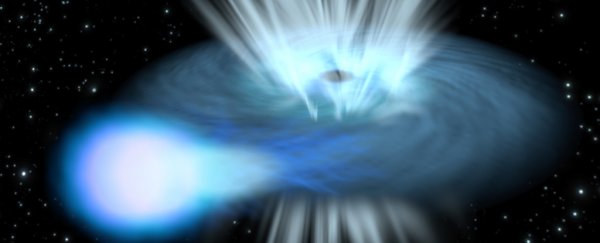Astronomers have found two black holes that are blasting out gas at speeds up to a quarter of the speed of light - and are breaking the currently accepted laws of physics in the process.
Located in distant star systems, way beyond our own galaxy, the researchers think these black holes are harboured by a rare type of binary star system that consumes gas at a much faster rate than usual. It's the first time anyone has been able to measure the gases coming off objects like these, and it could teach us a whole lot about the way our Universe works.
Most of the large X-ray sources in space are familiar to scientists: they're either supermassive black holes that devour nearby matter, or they're binary systems containing a stellar remnant (a white dwarf, neutron star, or black hole, for example) that pull material away from a companion star.
What we're apparently dealing with here is a third type of X-ray source: an "ultra-luminous X-ray source", says the team from the University of Cambridge in the UK, that consumes gas at a much higher rate than other binary systems.
The way that these objects attract and repel matter is known as Eddington luminosity - named after British astronomer Arthur Eddington - but no one has seen speeds like these until now.
Based on readings captured by the ESA's XMM-Newton space telescope, swirling gas is being ejected by these black holes at around 70,000 kilometres per second (157 million mph) - or to put it another way, a quarter of the speed of light.
"This is the first time we've seen winds streaming away from ultra-luminous X-ray sources," said lead researcher Ciro Pinto. "And the very high speed of these outflows is telling us something about the nature of the compact objects in these sources, which are frantically devouring matter."
Pinto and his colleagues collected several days' worth of data from nearby galaxies less than 22 million light-years away from the Milky Way.
By studying the X-ray emissions from the gas as it travelled, the astronomers were able to measure its speed - gas in systems like these is drawn in by the mass of the central object and repelled by radiation.
Now it appears that the natural limits set in place by Eddington's calculations have been exceeded, and the researchers want to carry out further study to find out exactly what's at the centre of these types of systems.
"With a broader sample of sources and multi-wavelength observations, we hope to finally uncover the physical nature of these powerful, peculiar objects," says Pinto.
Universe, please never stop amazing us. Thank you.
The team's work has been published in the journal Nature.
